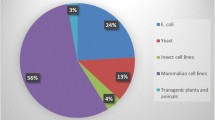Abstract.
The amino acid analogue selenomethionine (SeMet) is shown to be efficiently incorporated into recombinant proteins expressed in Escherichia coli grown in a simple minimal medium without the addition of synthetic amino acids. Furthermore, satisfactory SeMet incorporation is obtained with a methionine-prototrophic strain transformed with commonly used vector systems. As examples, purified tryparedoxin 1 from Crithidia fasciculata, alkylhydroperoxide reductase (AhpC) from Mycobacterium marinum and the 16-kDa antigen from M. tuberculosis are shown to be efficiently labelled with SeMet, using the culture conditions and the host/vector systems described here. Enzymatic analysis reveals no differences between native and SeMet-labelled tryparedoxin 1 enzyme. Both proteins yield crystals under similar conditions. The culture conditions and host vector systems described greatly facilitate selenium-labelling of proteins for 3-D structure determination.
Similar content being viewed by others
Author information
Authors and Affiliations
Additional information
Received revision: 12 April 2001
Electronic Publication
Rights and permissions
About this article
Cite this article
Guerrero, .S., Hecht, .HJ., Hofmann, .B. et al. Production of selenomethionine-labelled proteins using simplified culture conditions and generally applicable host/vector systems.. Appl Microbiol Biotechnol 56, 718–723 (2001). https://doi.org/10.1007/s002530100690
Received:
Accepted:
Issue Date:
DOI: https://doi.org/10.1007/s002530100690




